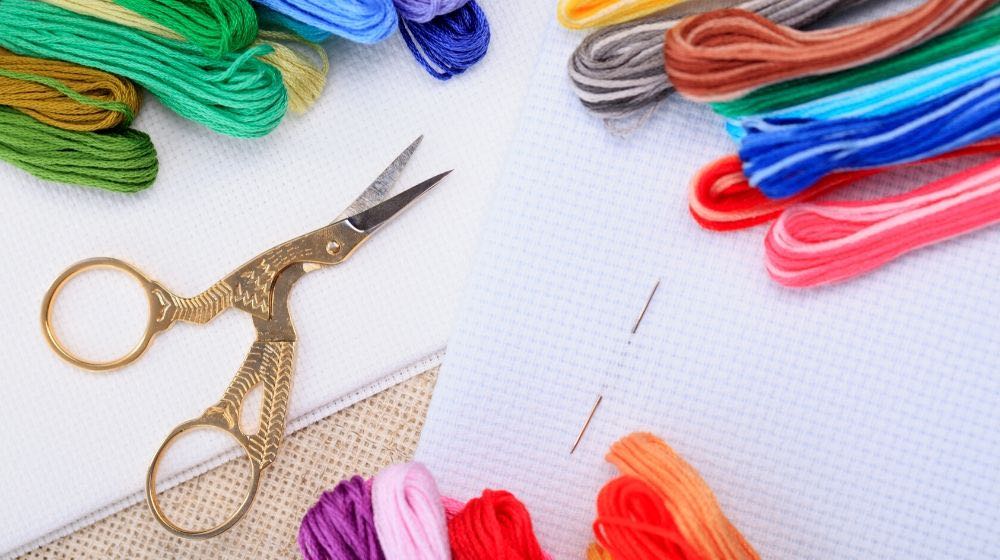Choosing the correct embroidery floss is a must when doing embroidery works. In this post, we will list all the thread types used for embroidery and what projects they are commonly used for.
RELATED: 20 Free Embroidery Patterns You Can Recreate For Every Occasion
Embroidery Floss | Everything You Need To Know
1. Stranded Embroidery Cotton or Embroidery Floss

Stranded embroidery cotton, commonly known as embroidery floss, is your standard thread when doing embroidery projects. Its versatility makes it the go-to thread for many. It has six strands that you can all use for sewing or separate it to a single strand depending on what you need for your project's effects and design.
For example, a needle painting work is best done with one strand, cross-stitch will look good using two strands, and a needlepoint project requires the full six strands.
2. Metallic Hand Embroidery Thread
Metallic embroidery thread, safe to say, is a great complementary thread. It is used to highlight embroidery designs and techniques thanks to its shiny and elegant-looking appearance. However, this thread tarnishes fast, tangles easily, frays, and it even snags.
With proper technique and discretion, this thread could separate your work from being good to excellent.
3. Pearl Cotton
Pearl cotton is slightly thicker than the embroidery floss and is only made of a single strand. If you'll look closely, it looks like two fibers intertwined. Don't separate it as the thread is meant like that. It also varies in weight.
You'll see a number in its identification and the higher the number, the lighter the material. This thread is typically used for cross stitch, Hardanger embroidery, tassels, and redwork.
4. Rayon Floss
|
Use rayon floss if you need to use bright colors in your project. The best qualities of a rayon floss is its brightness and silk-like texture. However, it is prone to tangling so use short lengths to avoid this problem.
Dampen the thread first for better handling. Run a wet sponge on it and that should do the trick.
5. Tapestry Yarn or Persian Yarn
Tapestry yarn has a soft and thick texture. Use this when working on projects such as canvas, needlepoint projects, crewelwork, and other heavy materials. It has two variants:
- Persian yarn – used for crewel embroidery, needlepoint embroidery, and cross-stitch. It is fuzzier than the tapestry yarn.
- Felted wool yarn – Best used for couching in embroidery. Undergoes a felting process, giving it a fuzzy texture.
6. Crewel Yarn or Wool
|
Crewel yarn/wool is made of fine, natural wool and looks like a two-ply strand. A single strand of this thread is as thick as a two-strand embroidery floss. Use wool for projects like wool embroidery, tapestry work, needlepoint, and cross-stitch.
RELATED: 17 Hand Embroidery Stitches Every Sewer Should Know [INFOGRAPHIC]
7. Variegated Threads
|
Use variegated threads for projects that need a wide assortment of colors. These threads have different shades of one color under the same skein.
It is available in different materials such as silk, cotton, and rayon. When buying variegated thread, choose one with subtle and gradual color change for easier pattern design.
8. Ribbons
Technically, ribbons are made of materials far different from embroidery floss. However, it is used and sewn in embroidery projects similar to embroidery floss. Use ribbons to make floral design since its thickness looks similar to flower petals.
9. Crochet Thread
Crochet projects are usually done using any of the threads mentioned in this post. However, this specialty yarn makes a world of difference when doing doilies and other crochet techniques like creating string art.
10. Cord & Beading Thread
|
These thicker cords are must-use when beading stitches as well as macrame. Use these threads for making jewelry, couching embroidery, leather sewing, crafting, stringing, wrapping, binding, knotting, beading, and lacing.
11. Knitting Yarn
Knitting yarn, as the name suggests, is used for knitting. It's better than the other threads because it retains shape and is resistant to wrinkling. It also has a varying thickness and can be identified by the number indicated as yarn weight.
12. Silk Threads
Silk threads is another favorite thread of many because of its bright and brilliant shades. It will look marvelous when used in coaching and fine embroidery. It's also a great complement to metallic threads.
The downside of using this thread is the color fades quicker compared to other threads and it has the tendency to bleed.
Want to learn how to easily separate embroidery floss or thread? Watch this quick tutorial by Made to Sew:
Being adept at using different kinds of embroidery floss will further improve your embroidery skills. Though each floss varies in terms of difficulty of use, it should eventually be easy for you with enough practice.
Each thread serves a purpose and being able to incorporate one or more in your projects will definitely make it look gorgeous.
What type of embroidery floss do you use often? Share your thoughts in the comments section below!
UP NEXT: